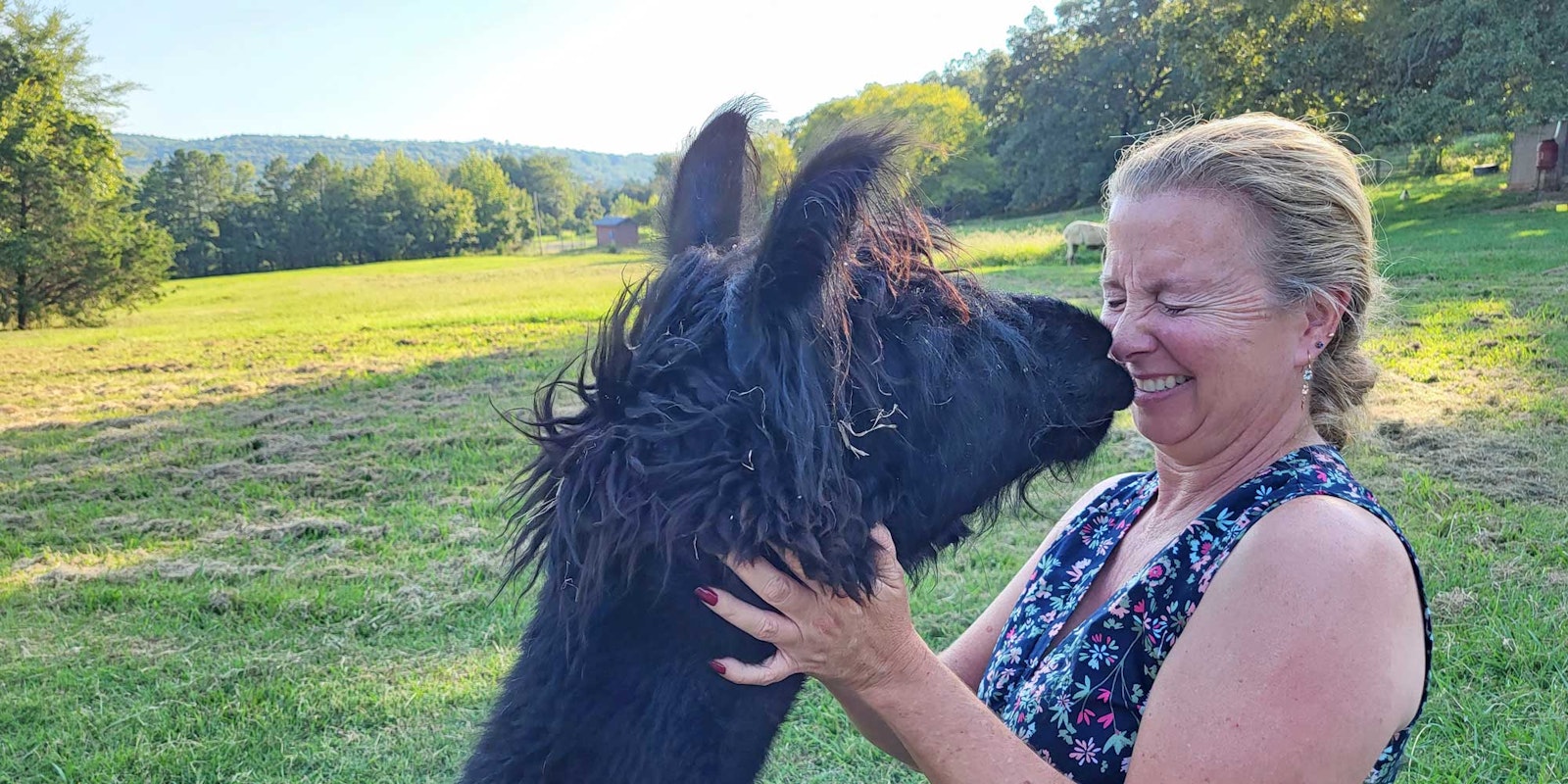Sona Gardner is the force of creativity and care behind Puddin Ridge Fibers, but she started out knowing almost nothing about using camelid fiber. After devoting many years to working with these fibers, she not only uses her the fibers from her animals, she also cares for rescued llamas and alpacas.
A Spinner is Born
When Sona acquired her first two llamas in 2013, she had no idea how to use the fiber that was shorn from her animals each year. She has fond childhood memories of her grandmother teaching her how to crochet, but it was not until 2017 that she acquired her first spindle.
Sona: I am a mostly self-taught fiber artist and fiber producer. I spin, weave, and dabble in dyeing fibers. Early on, I joined an online spinning group that meets in person once a month. I watched and learned. I am a big believer in trying things before you invest too much of anything into a new skill or hobby. With my fiber journey, I started with the least expensive thing I could find and played with it to see if it was something I wanted to do. All of my equipment was purchased used with the exception of my first spinning wheel, which my father built for me.
 Some of the rescued llamas and alpacas at Puddin Ridge Fibers. You can spot the llamas because they are taller than alpacas, have a higher tail set, and have distinctive long banana-shaped ears (unlike the spear-shaped ears of alpacas).
Some of the rescued llamas and alpacas at Puddin Ridge Fibers. You can spot the llamas because they are taller than alpacas, have a higher tail set, and have distinctive long banana-shaped ears (unlike the spear-shaped ears of alpacas).
Puddin’s Rescues
Today, Sona’s herd has grown to three alpacas and eight llamas, most of which are rescues. Her love and care for them clearly shows in the way she describes the four-legged characters that grace her pastures.
Sona: We have one girl that’s twenty-two years old, and she was one of our first llamas. She is down to her last two teeth and gets extra-special care. There is also a twenty-year-old female alpaca with terrible leg conformation, but she’s still clipping along. And we have a completely blind neutered male alpaca that’s been hospitalized once for heart issues, but he’s still here!
 Sona Gardner offers yarn and fiber from not only her own herd of llamas and alpacas but also fiber that would be discarded from other farms.
Sona Gardner offers yarn and fiber from not only her own herd of llamas and alpacas but also fiber that would be discarded from other farms.
Responsible Fleece
A few years after learning how to use the fleeces from her own herd, Sona discovered that many alpaca and llama owners did not use their fibers. Now not only does she rescue animals, she also rescues fiber from farmers who would otherwise throw it out. Although it takes time to sort these castaways, she enjoys finding creative ways to responsibly use all the fibers that end up at her studio.
Sona: I believe that all fiber has a purpose. You can do something with each part of a fleece. You just have to figure out what that is, even if it means mulching your garden with leftovers. In fact, there is a non-profit called Matter of Trust that offers a service called the “Clean Wave Program.” Fiber producers can donate their unwanted raw fibers for the creation of compostable fiber mats. These mats benefit the environment by soaking up oil spills and other unfriendly chemicals.
Helping Llamas and Alpacas in Need
As coordinator for the Southeast Llama Rescue, Sona also works closely with Southwest Llama Rescue to help find llamas and alpacas new homes. When an animal is given to a rescue, it is thoroughly vetted and halter-trained before being offered for adoption.
Sona: Thankfully, we receive very few neglect cases. Most animals are surrendered to us after their caretakers experience a life-changing event. While some do come to us after languishing in a field for a couple of years due to their caretaker’s absence, most of the animals are in good shape. We are very particular about where animals are rehomed. New owners are encouraged to adopt, but they need to be open to learning about the best care practices for these special animals.
We are getting more alpacas in, and they need care. There is so much that goes into making sure an animal is ready for adoption. We make sure that all the males are neutered and the females have non-breeding contracts. When an animal is adopted, their new caretaker gets a halter, a lead, a book on llama and alpaca care, and a mentor who is willing to help with any questions that may arise.
How You Can Help
Llamas and alpacas provide yarns with incredible color, drape, and softness. One of the ways you can help llamas and alpacas in need is by purchasing fiber and yarn directly from Sona via her Facebook page, Puddin Ridge Fibers. The funds go directly to caring for her animals and hosting community-outreach events. You can also donate to the Southeast Llama Rescue and the Southwest Llama Rescue. Consider paying it forward by helping farmers such as Sona who have stepped up to care for these creatures.
Jacqueline Harp is a freelance writer and multimedia fiber artist who spins, felts, weaves, crochets, and knits in every spare moment possible. She is also a former certified Master Sorter of Wool Fibers through the State University of New York (Cobleskill) Sorter-Grader-Classer (SGC) Program. Her Instagram handle is @foreverfiberarts.

